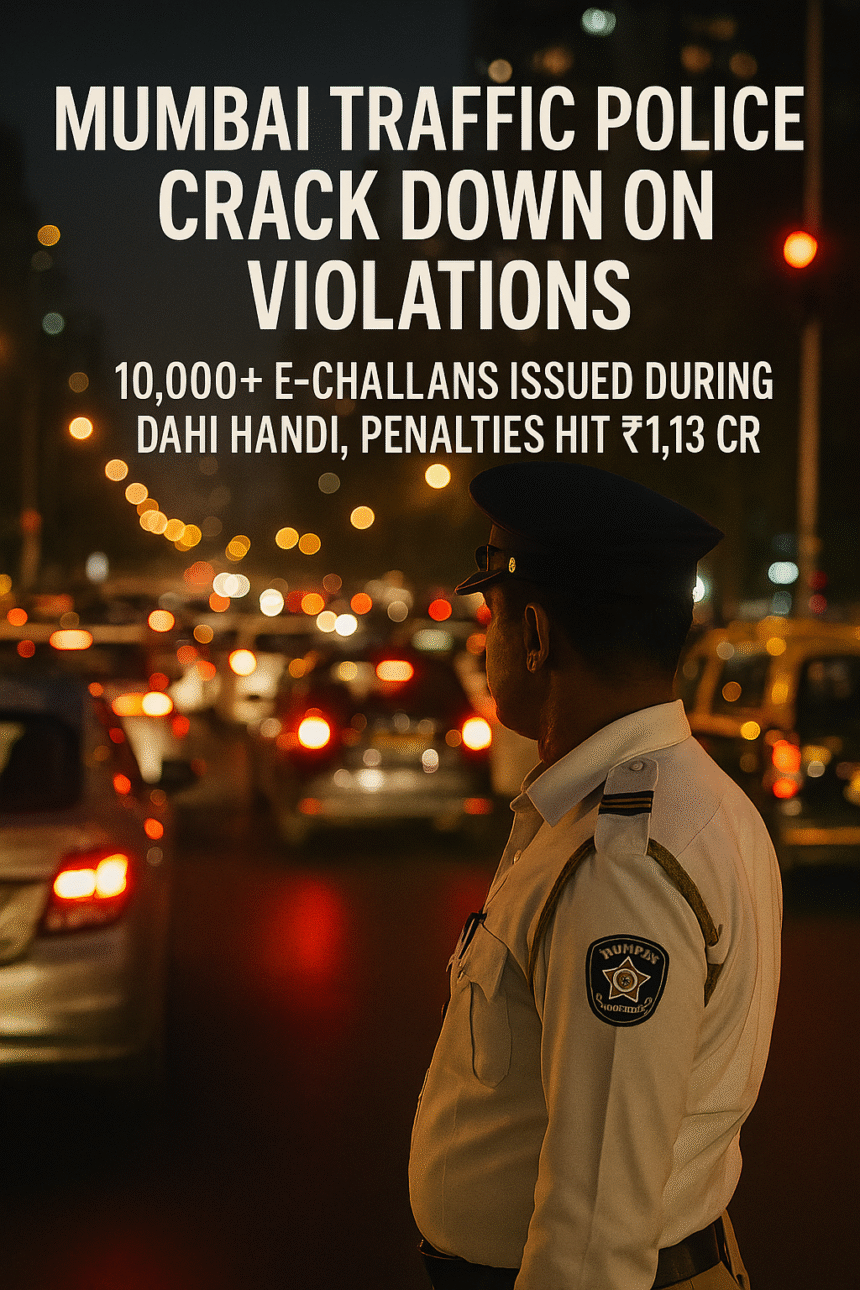Mumbai traffic police issued more than 10,000 e‑challans on Saturday, raking in a staggering ₹1.13 crore in penalties during the city’s annual Dahi Handi celebrations. The crackdown marks a decisive step in the digital enforcement of traffic violations, leveraging technology to curb safety breaches amid festive chaos.
Background and Context
Every year, Mumbai’s street‑famed Dahi Handi, a part of the Ganesh Chaturthi festivities, draws millions of devotees and revelers. Streets and junctions are flooded with traffic, and the rush for the so‑called “devil’s cups” often leads to reckless driving, wrong‑way turns, and cluster rides that spike the risk of accidents.
Traditionally, traffic police relied on manual checks and ticketing after the heat of the day. However, recent advancements in digital policing tools—including anonymous data capture, real‑time CCTV analytics, and automated challan generation—have paved the way for stricter and more efficient enforcement. This year’s deployment was a clear acknowledgment of how technology can keep streets safer when crowds swell.
Key Developments
At the height of the celebration, traffic officers stationed across key junctions, such as the Thane–Vashi bypass, Andheri East, and the junctions near the Maratha Mandir, recorded infractions via digital registrars.
- 10,002 e‑challans issued: Issued for helmet non‑compliance, wrong‑way driving, triple riding, speeding, and illegal vehicular access to pedestrian zones.
- ₹1.13 crore in penalties: The total fines collected reflect an expanded range of offences—some as low as ₹500, others up to ₹5,000 per violation.
- Real‑time analytics: Police used AI‑driven recognition to flag heavily violating vehicles from CCTV footage within minutes, prompting immediate action.
- Post‑event review: Joint Commissioner Anil Kumbhare confirmed that further e‑challans would be issued after a detailed audit of CCTV clips, ensuring no violation slipped through.
The police’s digital system streamlined the process: offenders received instant notifications, could pay fines online, and were added to a national database, raising their risk for future mismatches.
Impact Analysis
**For local commuters:** The incident underscores the seriousness of adhering to traffic norms. With digital challans in place, what once might have been a verbal warning now becomes a formal legal record, creating a mandatory deterrent.
**For international students and visitors:** Many students traveling to Mumbai for conferences, internships, or cultural trips might unknowingly enter large traffic lanes during festival periods. The two‑fold impact includes:
- **Financial risk** – fines can accumulate quickly if multiple violations occur.
- **Legal complications** – a digital record can appear in transport databases, potentially affecting future visa applications or local insurance claims.
Urghani Abbas, a Malaysian student studying at the Indian Institute of Technology (IIT) Bombay, shared, “I still rely on shared auto rides during festivals. The last time I was caught speeding, the system flagged me, and I had to pay an on‑line fine within 24 hours. It’s a hard lesson, but I’m now more careful and aware of the e‑challan system.”
Expert Insights and Practical Tips
Traffic enforcement authorities confirm that digital tools can help participants stay safe:
- Use public transport: Opt for metro or suburban trains during festive peaks. They have dedicated lanes and avoid road diversions.
- Ride responsibly: For those traveling by two‑wheelers, always wear a helmet and ensure it is properly secured.
- Check routes: Use navigation apps that inform you about blocked roads or alternate paths—most apps now integrate data from city traffic authorities.
- Plan ahead: For international students, obtain travel advisories from their home country’s embassy and set up a local mobile ID to handle any digital challan quickly.
- Know the penalties: While minor infractions might carry low fines, the cumulative effect can be significant.
- Appeal process: If you believe you were wrongly cited, you can file an online appeal within 7 days of receiving the e‑challan.
Police commissioner Anil Kumbhare advises, “The digital enforcement of traffic violations is here to stay. Those who dare to violate the rules during festive times face higher scrutiny—particularly via CCTV. Compliance isn’t just a legal requirement; it’s a communal safety measure.”
For students, knowledge is power. “Always carry your ID and keep a digital copy,” stresses D. Kumar, a student liaison officer at the University of Mumbai. “It speeds up the payment process for any inadvertent violation, saving both time and money.”
Looking Ahead
The success of this enforcement operation suggests that the Mumbai Traffic Police will extend their digital approach to other statewide festivals and peak traffic periods. Potential developments include:
- **AI‑driven driver behaviour monitoring** to predict risky movements before they occur.
- **City‑wide app integration**—students can link their IDs and receive real‑time alerts for closed roads or alert them to risk zones.
- **Cross‑regional data sharing**—violators in Mumbai could see a flag in other states, complicating future travel plans.
With the digital enforcement of traffic violations on an upward trajectory, the city is poised to reclaim its streets from chaos without stifling cultural celebrations. The dual priority—preserving tradition while safeguarding public safety—will likely shape policy in the coming years.
Reach out to us for personalized consultation based on your specific requirements.
